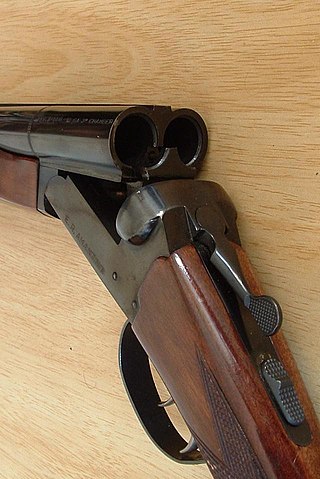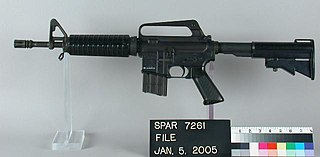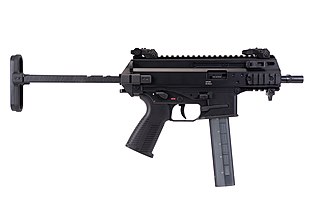
A submachine gun (SMG) is a magazine-fed automatic carbine designed to fire handgun cartridges. The term "submachine gun" was coined by John T. Thompson, the inventor of the Thompson submachine gun, to describe its design concept as an automatic firearm with notably less firepower than a machine gun. As a machine gun must fire rifle cartridges to be classified as such, submachine guns are not considered machine guns. The submachine gun was developed during World War I (1914–1918) as a close quarter offensive weapon, mainly for trench raiding. At its peak during World War II (1939–1945), millions of submachine guns were made for assault troops and auxiliaries whose doctrines emphasized close-quarter suppressive fire. New submachine gun designs appeared frequently during the Cold War, especially among special forces, covert operation commandos and mechanized infantrymen. Submachine gun usage for frontline combat decreased in the 1980s and 1990s, and by the early 21st century, submachine guns have largely been replaced by assault rifles, which have a longer effective range, have increased stopping power, and can better penetrate the helmets and body armor used by modern soldiers. However, they are still used by security forces, police tactical units, paramilitary and bodyguards for close-quarters combat because they are "a pistol-caliber weapon that's easy to control, and less likely to overpenetrate the target".

In firearms terminology, an action is the functional mechanism of a breechloading firearm that handles the ammunition cartridges, or the method by which that mechanism works. Actions are technically not present on muzzleloaders, as all those are single-shot firearms with a closed off breech with the powder and projectile manually loaded from the muzzle. Instead, the muzzleloader ignition mechanism is referred to as the lock.

The Colt AR-15 is a product line of magazine-fed, gas-operated, autoloading rifle manufactured by Colt's Manufacturing Company ("Colt") in many configurations. The rifle is a derivative of its predecessor, the lightweight ArmaLite AR-15, an automatic rifle designed by Eugene Stoner and other engineers at ArmaLite in 1956.

The Thompson submachine gun is a blowback-operated, selective-fire submachine gun, invented and developed by Brigadier General John T. Thompson, a United States Army officer, in 1918. It was designed to break the stalemate of trench warfare of World War I, although early models did not arrive in time for actual combat.

The M1 carbine is a lightweight semi-automatic carbine chambered in the .30 carbine (7.62×33mm) cartridge that was issued to the U.S. military during World War II, the Korean War, and the Vietnam War. The M1 carbine was produced in several variants and was widely used by paramilitary and police forces around the world after World War II.

The .45 Reising submachine gun was manufactured by Harrington & Richardson (H&R) Arms Company in Worcester, Massachusetts, USA, and was designed and patented by Eugene Reising in 1940. The three versions of the weapon were the Model 50, the folding stock Model 55, and the semiautomatic Model 60 rifle. Over 100,000 Reisings were ordered during World War II, and were initially used by the United States Navy, Marine Corps, and the United States Coast Guard, though some were shipped to Canadian, Soviet, and other allied forces to fight the Axis powers.
The La France M16K is an M16 rifle modified by the company La France Specialties, which among with other firearm-related activities, convert common military weapons into more compact configurations typically for law enforcement and special forces use.

Personal defense weapons (PDWs) are a class of compact, magazine-fed automatic firearms that are typically submachine guns designed to fire rifle-like cartridges. Most PDWs fire a small-caliber, high-velocity centerfire bottleneck cartridge resembling a scaled-down intermediate cartridge, essentially making them an "in-between" hybrid between a submachine gun and a conventional carbine.

The PP-19 Bizon is a 9×18mm Makarov submachine gun developed in 1993 by the Russian company Izhmash. The Bizon was designed by a team of engineers headed by Victor Kalashnikov and including Alexei Dragunov.

The Colt Automatic Rifle-15 or CAR-15 is a family of M16 rifle–based firearms marketed by Colt in the 1960s and early 1970s. However, the term "CAR-15" is most commonly associated with the Colt Commando ; these select-fire carbines have ultrashort 10.5-inch (270 mm) and 11.5-inch (290 mm) barrels with over-sized flash suppressors.

The ArmaLite AR-10 is a 7.62×51mm NATO battle rifle designed by Eugene Stoner in the late 1950s and manufactured by ArmaLite. When first introduced in 1956, the AR-10 used an innovative combination of a straight-line barrel/stock design with phenolic composite, a new patent-filed gas-operated bolt and carrier system and forged alloy parts resulting in a small arm significantly easier to control in automatic fire and over 1 lb (0.45 kg) lighter than other infantry rifles of the day. Over its production life, the original AR-10 was built in relatively small numbers, with fewer than 10,000 rifles assembled. However, the ArmaLite AR-10 would become the progenitor for a wide range of firearms.
The Ruger 10/22 is a series of semi-automatic rifles produced by American firearm manufacturer Sturm, Ruger & Co., chambered for the .22 Long Rifle rimfire cartridge. It uses a patented 10-round rotary magazine, though higher capacity box magazines are also available. The standard carbine version of the Ruger 10/22 has been in production continuously since 1964, making it one of the most successful rimfire rifle designs in history, with numerous third party manufacturers making parts and accessories for upgrading and customization. The 10/22's aftermarket is so prolific that a complete 10/22 can be built without using any Ruger-made components.

The ArmaLite AR-7 Explorer is a semi-automatic firearm in .22 Long Rifle caliber, developed in 1959 from the AR-5 that was adopted by the U.S. Air Force as a pilot and aircrew survival weapon. The AR-7 was adopted and modified by the Israeli Air Force as an aircrew survival weapon in the 1980s.

The Claridge Hi-Tec and its antecedent the Goncz High-Tech Long Pistol are semi-automatic pistols designed by Hungarian inventor Lajos John Goncz. This unique firearm features a telescopic bolt design encased in a tubular upper receiver with a forged steel frame, button rifled match barrels, and 16-round magazines standard.

A takedown gun is a long gun designed to be taken apart, significantly reducing its length, making it easier to store, pack, transport, and conceal. A variety of barrel, stock, and receiver designs have been invented to facilitate takedown. For example, the hinged design of many break-action firearms allows takedown. Some regular firearms can be modified to allow takedown after custom gunsmithing.

Auto-Ordnance was a U.S. arms development firm founded by retired Colonel John T. Thompson of the United States Army Ordnance Department in 1916. Auto-Ordnance is best known for the Thompson submachine gun, used as a military weapon by the Allied forces in World War II, and also notorious as a gangster weapon used during the Roaring Twenties.

The B&T APC is a family of submachine guns and rifles produced and manufactured by B&T of Switzerland. Announced in 2011, the standard series uses standard 9×19mm (APC9), .40 S&W (APC40), 10mm Auto (APC10), and .45 ACP (APC45) ammunition.

Tilting bolt action is a type of locking mechanism often used in self-loading firearms and, rarely, in straight-pull repeating rifles. Essentially, the design consists of a moving bolt driven by some mechanism, most often a piston with gas pressure from the gas port behind the muzzle. The bolt drops down into receiver recess and locks on bolt closing. Tilting the bolt up and down locks-unlocks in the breech. This tilting allows gas pressure in the barrel from firing the gun to lower to safe levels before the cartridge case is ejected.














